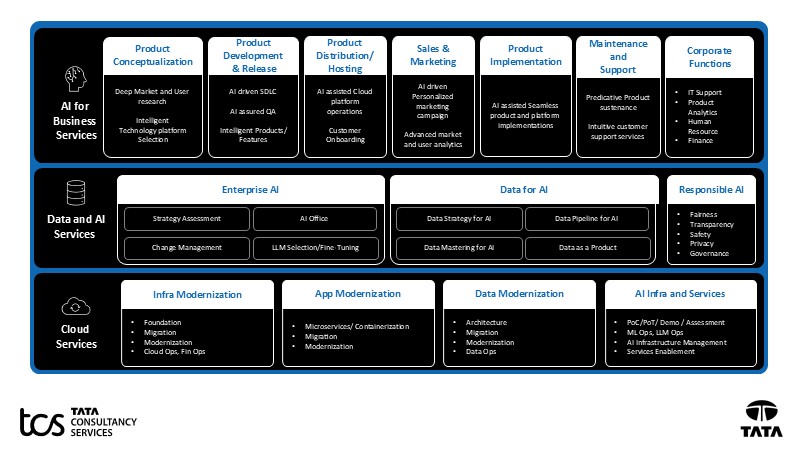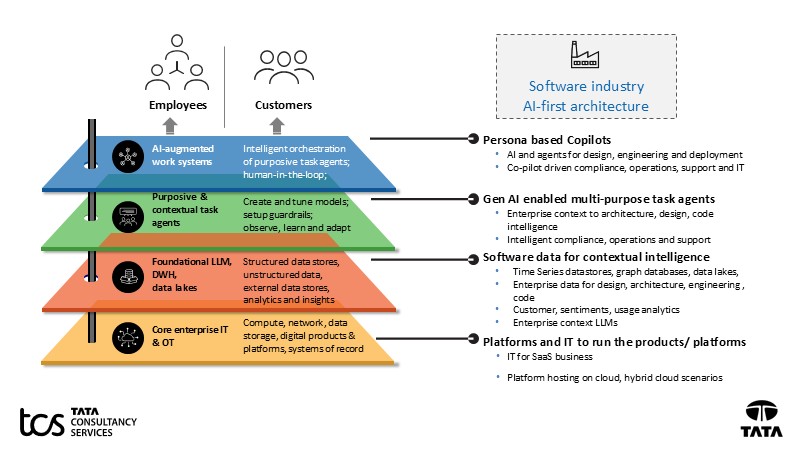Industry
Highlights
- Generative artificial intelligence (GenAI) is revolutionizing the software industry, driving innovation across areas, be it code creation or customer engagement, and is projected to significantly boost market growth by 2028.
- AI-powered tools are enhancing every phase of the software development life cycle (SDLC) – from product conceptualization to maintenance – leading to faster development cycles and higher quality products.
- Investing in AI will offer software companies substantial business benefits, including improved operational efficiency, new revenue streams, and the ability to adapt to rapidly changing market conditions.
On this page
From code to creativity, generative AI is redefining the software industry
Generative AI (GenAI) will enable the launch of intelligent products and modernization of existing ones, unlocking new markets and revenue streams.
Technology is set to revolutionize the software industry, driving substantial market growth and innovation. Cloud services, particularly those offered by leading platforms such as Amazon Web Services (AWS), Google Cloud, and Microsoft Azure, are key drivers of this expansion. Public cloud spending is expected to rise significantly, further fueling this growth. Within this evolving landscape, the adoption of GenAI is anticipated to rise rapidly.
The software industry is increasingly adopting artificial intelligence- (AI) powered product lifecycle management, which promises to significantly enhance productivity. Additionally, there is a broad uptake of intelligent products, software as a service (SaaS), immersive customer experiences, and AI-driven solutions in sectors such as cybersecurity. Enterprise software engineers are expected to leverage AI coding assistants, underscoring the transformative potential of GenAI across the industry.
We explore the potential areas where GenAI can drive innovation and business growth across the software development life cycle.
- Accelerated product launch: AI can streamline the creation of specifications, designs, architecture, code, test cases, test data, deployment scripts, and documentation, significantly speeding up development cycles.
- Differentiated products: GenAI can enable intelligent, intuitive features and functionalities, enhancing user experience through AI-powered recommendations and decision making.
- New markets and revenue streams: Large language models (LLMs) and customized AI solutions can power innovative products such as copilots, verticalized products, intelligent assistants, and specialized analyzers, opening up newer growth avenues for software companies.
- Seamless customer engagement: AI is reimagining customer engagement by enabling intelligent, contextual interactions both inside and outside the product, offering more immersive, personalized experiences.
- Efficient, reliable, and cost-effective operations: AI can drive automation and optimize processes such as contract management, customer onboarding, and order-to-cash workflows. This will ensure smoother, faster, and more reliable business operations.
How generative AI will drive transformation across the SDLC
GenAI can enhance each stage of the product lifecycle, elevate customer experience, and increase the reliability and efficiency of products.
Software companies can use GenAI to enhance the following processes:
Product conceptualization: Gen AI can power advanced market research, deeper market and customer intelligence, and faster hypothesis validation, enabling innovation and faster product launches. It can also facilitate smarter decisions about technology and platform selection.
Product development and release: GenAI can accelerate product development with rapid prototyping, hypothesis validation, feature specification generation, and better architectural decision making and user interface design. It can help software companies reduce technical debt to modernize products and improve customer interactions. Additionally, GenAI can improve engineering productivity by automating code generation, optimization, and refactoring. It can also create test plans, scripts, and deployment automation, resulting in faster development cycles and higher quality software products.
Product distribution and hosting: GenAI- and agentic AI-driven automation assist in deployment, intelligent troubleshooting, platform and optimization, ensuring efficient operations and reduced downtime. Predictive analytics and automation enhance product and cloud operations and customer onboarding and reduce the environmental impact of hosting.
Sales and marketing: AI-driven insights, personalized targeting, and proactive engagement enable optimizing campaigns and better channel management. GenAI is diving content creation and customer segmentation, thereby allowing software companies to adopt highly targeted and effective marketing strategies.
Product implementation: GenAI can ensure efficient deployment and migration of software while enabling effective user training to ensure seamless transitions for organizations. It allows for seamless configuration, code generation, and blueprint creation, speeding implementation timelines and improving quality.
Maintenance and support: Predictive maintenance and AI-driven troubleshooting of software issues will drive proactive customer service and reduce costs.
By augmenting decision making across these use cases, GenAI creates a more agile, efficient, and customer-focused software value chain.
Table 1 outlines the activities involved in each phase of the software value chain. We explore the associated GenAI use cases, benefits, and personas for each stage, highlighting how these elements work together to create a higher-value product and improve business results.
|
Product conceptualization |
Product development and release |
Product distribution and hosting |
Sales and marketing |
| Activity |
|
|
|
|
| Use cases |
|
|
|
|
| Personas |
|
|
|
|
| Benefits |
|
|
|
|
Table 1: GenAI interventions across the software development life cycle
Generative AI-driven solutions for key business areas
In the rapidly evolving software industry, leveraging GenAI and data is crucial for driving innovation and efficiency.
GenAI can help software companies enhance product development, optimize data strategies, and modernize their infrastructure for greater operational excellence (see Figure 1).
AI for business services
In the product conceptualization stage, GenAI aids in market and user research and platform selection, providing deeper insights. For product development and release, AI can streamline QA, build intelligent features, and accelerate the SDLC. During product distribution and hosting, AI can enhance cloud operations and automate customer onboarding. In sales and marketing, AI enables personalized campaigns and advanced market analytics. Product implementation can be simplified with AI-assisted deployments, improving speed and quality. Maintenance and support functions can use AI for predictive maintenance and intuitive customer support. In corporate functions, AI can boost IT support, product analytics, HR, and finance, and driving operational efficiency.
Data and AI services
Enterprise AI includes strategy assessment, change management, and LLM fine-tuning for tailored AI solutions. Data for AI focuses on data strategy, pipelines, and data as a product to power AI. Responsible AI ensures fairness, transparency, privacy, and governance.
Cloud services
Infrastructure modernization includes migration, modernization, and cloudops and finops for optimized IT and AI infrastructure. App modernization focuses on microservices and containerization for agility, while data modernization ensures scalable architecture and data ops. AI services offer proof-of-concept (PoC), machine learning ops, LLM finetuning and ops, and services enablement to accelerate AI integration.
A business case for AI-first software companies
Developing a robust business case for AI is challenging because quantifying its business benefits and costs is difficult.
How can the software industry prepare for an AI evolution?
First, any AI solution must start with a value-augmentation opportunity for the business; this means prioritizing use cases rather than starting with technology adoption. For software companies to fully tap into the potential of AI, it is essential to have access to multitier architecture and integration to enterprise systems (see Figure. 2). Companies must adopt a multi-tiered approach for AI technologies.
- Core: The bottom-most layer predominantly enables the compute, network, and data storage as a foundation functions. The existing enterprise and platforms IT systems support SaaS businesses, with cloud and hybrid cloud hosting for scalability and platform management.
- Foundational: The next layer uses foundational LLMs and data warehouses to manage and process vast amounts of structured and unstructured data. Software data for contextual intelligence drives data insights from time-series data stores, graph databases, and data lakes. AI models are used for design, engineering, and customer sentiment analysis.
- Task agents: The layer above constitutes GenAI and agentic AI- enabled purposive and contextual task agents to enable various moving parts of AI. This includes the finetuning of AI models on an ongoing basis, establishing necessary guardrails for responsible AI, and adapting through continuous learning. GenAI-powered multipurpose agents provide enterprise context for architecture, design, and code intelligence.
- AI-augmented work systems: The top layer comprises task agents that interact with each other within each stage of the software value chain in a seamless fashion with a human in the loop. This enables collaborative and adaptive workflows and persona-based copilots for design, engineering, and deployment. AI technologies offer support for compliance, operations, and IT.
We believe GenAI will enable software companies to launch intelligent and intuitive products faster, making way for new markets and unlocking new revenue streams. Software companies must start exploring GenAI and agentic AI to not only eliminate repetitive tasks but also optimize processes and improve overall productivity amid rapid fluctuations. Companies that will thrive in this era of accelerated change are those that can continuously adapt in response to a highly dynamic environment. These are the perpetually adaptive enterprises—dynamic, resilient entities that don’t just keep pace with change but shape it—to become catalysts for innovation, growth, and purpose-led impact.








